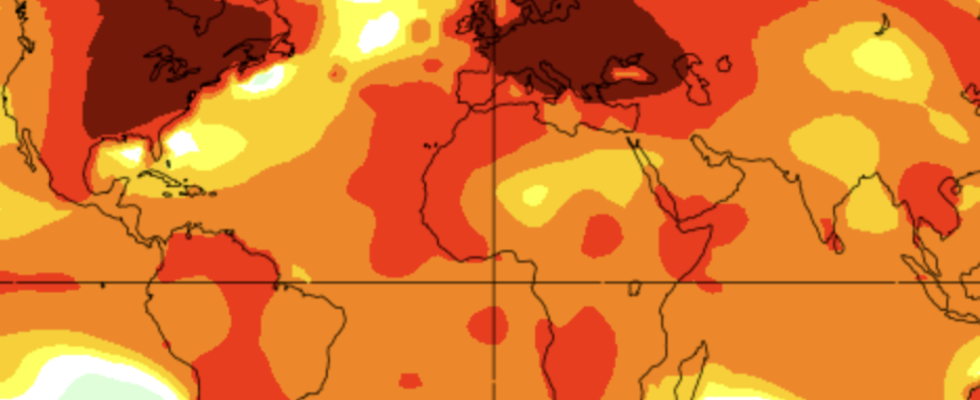Weather phenomena
Hot, hotter, Europe: Why is the continent heating up faster than the rest of the world?
Global warming: The more land area, the higher the temperatures
© NASA
A February that was too warm was followed by a March that was too warm in Germany. Last year’s temperature records continue in Europe. Why is that? And what role does climate change play?
What at first glance hardly seems worth mentioning actually scratches the 1.5 degree mark over a period of 30 years. has been calculated by the Berkely Earth research institute. That red guard rail that, according to numerous scientists, must be maintained at all costs. Several studies have recently shown that this is no longer possible. Leading climatologists therefore believe it is more realistic to limit the temperature increase by two degrees.
“The necessary climate protection measures that we are now pushing forward will not benefit this generation, but only the next generation,” admits meteorologist Peter Hoffmann from the Potsdam Institute for Climate Impact Research. The already drastic climate changes will therefore continue for at least the next two to three decades. This also applies to the record-breaking warming in Europe.
But why is it that this continent of all places is heating up so quickly compared to the rest of the world?
Basically, the northern hemisphere is heating up significantly more and faster than the south. This is due to the different distribution of land and water masses. Oceans cover 70 percent of the entire planet, especially the southern hemisphere. Unlike landmasses, they warm up much more slowly and thus lower the global average temperature.

Land areas store heat faster than water masses. Due to the different distribution, the northern hemisphere heats up more than the south of the planet. But the poles also play a role.
© NASA
Weather patterns in Europe are changing
In Europe, the rise in temperatures is probably mainly related to changing weather patterns. Meteorologists are increasingly observing southwestern high altitudes across the continent. These are air currents that reach the continent from the Atlantic from a southwesterly direction and bring warmer air to Europe. Unlike lows, they can last for several days or weeks. “Actually, these are natural weather phenomena that bring heat in summer,” explains Hoffmann. These phenomena are now no longer limited to the summer, but begin in February.
It is still unclear what role climate change plays in this. Hoffmann assumes that the warming of the oceans – for which there is still no explanation – is also contributing to the European temperature increase. The North Atlantic in particular, the “weather kitchen of Europe”, has recently warmed up significantly. “This is very unusual, but it contributes to the fact that certain weather conditions can lead to even higher temperatures today than decades ago,” explains the meteorologist.
When the ice melts
Some climate researchers assume that the warming of the Arctic is also favoring such high altitudes. Compared to the global average temperature, the region is warming three to four times faster. The melting polar ice caps are exposing ocean areas. The sun’s rays are then no longer reflected by bright surfaces – experts refer to this as the albedo effect – but are stored by dark surfaces. This in turn accelerates the melting of snow. At the same time, the temperature difference between the poles and the equator, which drives the polar jet stream, is decreasing.
The strong wind moves around the entire globe and causes varied weather in Europe. If the temperatures between the pole and the equator equalize, the jet stream slows down “and tends to move in waves across the globe,” explains meteorologist Hoffmann. Instead of moderate westerly winds from the Atlantic, the changes are favoring more frequent southwesterly winds. If the flow of warm air masses from southern Spain persists for weeks, new temperature records would be likely.
On the other hand, cold air outbreaks can also cause constant storm lows to form over the Mediterranean region, which can also lead to heavy, continuous rain in Germany.
What role does climate protection play?
Climate researchers also expressed the theory to ZDF that clean air also plays a role. Similar to bright (snow) surfaces, particles in the atmosphere also reflect solar radiation and thus cool the planet. This effect has been declining more and more significantly in Europe since the 1990s. The reason for this is, among other things, desulfurization systems in power plants.
In search of solutions, researchers and entrepreneurs are toying with the idea of To release sulfur in a targeted mannerto curb global warming. However, such geoengineering approaches are highly controversial, especially in Germany, because the consequences are not yet foreseeable.
Will Europe become a desert?
However, the fact that Europe is heating up so much compared to other regions of the world does not mean that the continent is more affected by global warming than other parts of the world. But: “Reliable forecasts about the various effects of climate change on individual regions of the world are subject to strong uncertainties,” says PIK researcher Hoffmann. Whether the heat-generating high altitudes hang permanently over Europe is currently being scientifically investigated. Should the jet stream slow down, as some studies suggest, this scenario could be confirmed. Other Models show otherwise, that the speed of the jet wind could increase again in the middle of the century due to climate change. Even if there are contradictions, climate researchers generally agree: extreme events are becoming more frequent.
“If we were to actively work to protect the environment and climate now, we could prevent worse things from happening,” summarizes Hoffmann. “But that only works with ambitious implementation.”
Sources: Copernicus observation program, Berkeley Earth, NOAA, NASA, NCAR, Max Planck Society


